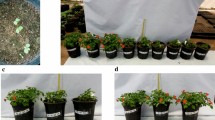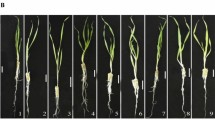Abstract
The effect of a moderate (PEG −0.75 MPa) and severe (PEG −1.5 MPa) water deficit on SA content in leaves and roots as well as the effect of pre-treatment with SA on reaction to water stress were evaluated in two barley genotypes — the modern cv. Maresi and a wild form of Hordeum spontaneum.
Water deficit increased SA content in roots, whereas SA content in leaves did not change. The level of SA in the roots of control plants was about twofold higher in ‘Maresi’ than in H. spontaneum. After 6 hours of a moderate stress the level of SA increased about twofold in H. spontaneum and about two and a half-fold in ‘Maresi’. Under severe stress conditions the level of SA increased about twofold in the both genotypes, but not before 24 hrs of the stress.
Plant treatment with SA before stress reduced a damaging action of water deficit on cell membrane in leaves. A protective effect was more noticeable in H. spontaneum than in ‘Maresi’. SA treatment increased ABA content in the leaves of the studied genotypes. An increase of proline level was observed only in H. spontaneum. The obtained results suggest that ABA and proline can contribute to the development of antistress reactions induced by SA.
Similar content being viewed by others
References
Bandurska H. 1991. The effect of proline on nitrate reductase activity in water-stressed barley leaves. Acta Physiol. Plant 1: 3–11.
Bandurska H., Gniazdowska-Skoczek H. 1995. Cell membrane stability in two barley genotypes under water stress conditions. Acta Soc. Bot. Pol. 64: 29–32.
Bandurska B. 1998. Implication of ABA and proline on cell membrane injury of water deficit stressed barley seedlings. Acta Physiol. Plant. 20: 375–381.
Bandurska H., Stroi ski A. 2003. ABA and proline accumulation in leaves and roots of wild (Hordeum spontaneum) and cultivated (Hordeum vulgare ‘Maresi’) barley genotypes under water deficit conditions. Acta Physiol. Plant. 25: 55–61.
Barkosky R.R., Einhlling F.A. 1993. Effect of salicylic acid on plant-water relationships. J. Chem. Ecol. 19: 237–247.
Bates L.S., Waldren R.P., Teare J.D. 1973. Rapid determination of proline for water stress studies. Plant and Soil 39: 205–207.
Bohnert H.J., Jensen R.G. 1996. Strategies for engineering water-stress tolerance in plants. TIBTECH 14: 89–97.
Coquoz J.L., Buchala A.J., Meuwly P.H., Métraux J.P. 1995. Arachidonic acid induces local but not systemic synthesis of salicylic acid and confers systemic resistance in potato plants to Phytophthora infestans and Alternaria solani. Phytopathology 85: 1219–1224.
Dat J.F., Lopéz-Delgado H., Foyer C.H., Scott I.M. 1998. Parallel changes in H2 O2 and catalase during thermotolerance induced by salicylic acid or heat acclimation in mustard seedlings. Plant Physiol. 116: 1351–1357.
Dexter S.T., Tottingham W.E., Graber L.F. 1932. Investigation of the hardiness of the plants by measurement of electrical conductivity. Plant Physiol. 7: 63–78.
Hare P.D., Cress W.A. 1997. Metabolic implications of stress-induced proline accumulation as an index of drought resistance using two contrasting barley cultivars. Plant Growth Regul. 21: 79–102.
Janda D.W., Szalai G., Tari A., Páldi E. 1999. Hydroponic treatment with salicylic acid decreases the effect of chilling injury in maize (Zea mays L.) plants. Planta 208: 175–180.
Janda T., Szalai G., Gonzales K., Veisz O., Páldi E. 2002. Changes in antioxidant activity and salicylic acid content after cold hardening in cereals. 13th Congress of FESPP, Greece. Book of Absracts p. 551.
Kacperska A. 1996. Are there common bases for plant responses to different stress factors. In: Ecophysiological aspects of plants responses to stress factors. (Eds.) Grzesiak, Miszalski. Scientific Meeting, Kraków: 49–58.
Khan W., Prithiviraj B., Smith D.L. 2003. Photosynthetic responses of corn and soybean to foliar application of salicylates. J. Plant Physiol. 50: 1–8.
Lee H.I., León J., Raskin I. 1995. Biosynthesis and metabolism of salicylic acid. Proc. Natl. Acad. Sci. USA 92: 4076–4079.
Malamy J., Klessig D.F. 1992. Salicylic acid and plant disease resistance. Plant J. 2: 643–654.
Malamy J., Klessig D.F. Raskin I. 1990. Salicylic acid: a likely endogenous signal in the resistance response of tobacco to viral infection. Science 250: 643–654.
Métraux J.P. 2002. Recent breakthroughs in the study of salicylic acid biosynthesis. Trends in Plant Science 8: 332–334.
Meuwly P.H., Métraux J.P. 1993. Ortho-anisic acid as internal standard for the simultaneous quantitation of salicylic acid and its putative biosynthesis precursors in cucumber leaves. Anal. Biochem. 214: 500–505.
Moore R. 1990. Abscisic acid is not necessary for gravitropism in primary roots of Zea mays. Annals of Botany 66: 281–283.
Pancheva T.V., Popova L.P., Uzunova A.N. 1996. Effects of salicylic acid on growth and photosynthesis in barley plants. J. Plant Physiol. 149: 57–63.
Rasmussen J.B., Hammerschmidt R., Zook M.N. 1991. Systemic induction of salicylic acid accumulation in cucumber after inoculation with Pseudomonas syringe cv. Syringe. Plant Physiol. 97: 1342–1347.
Raskin I. 1992a. Role of salicylic acid in plants. Annu. Rev. Plant Physiol. Mol. Biol. 43: 439–463.
Raskin I. 1992b. Salicylate, a new plant hormone. Plant Physiol. 99: 799–803.
Senaratana T., Touchell D, Bunn E., Dixon K. 2000. Acetyl salicylic acid (Aspirin) and salicylic acid induce multiple stress tolerance in bean and tomato plants. Plant Growth Regul. 30: 157–161.
Shakirova F.M., Sakhabutdinova A.R., Bezrukova M.V., Fatkhutdinova R.A., Fatkhutdinova D.R. 2003. Changes in hormonal status of wheat seedlings induced by salicylic acid and salinity. Plant Science 164: 317–322.
Sullivan C.Y. 1971. Techniques for measuring plant drought stress. In: Drought Injury and Resistance in Crops. (Eds.) K.L. Larson and J.D. Eastin. Crop Sci. Soc. Am., Madison Wis. pp. 1–18.
Weatherly P.E. 1950. Studies in water relation of cotton plants. I. The measurement of water deficits in leaves. New Phytol. 49: 81–97.
Wilkinson S., Davies S.W.J. 2002. ABA-based chemical signalling: the co-ordination of responses to stress in plants. Plant, Cell Environ. 25: 195–210.
Yalpani N., Enyedi A., León J., Raskin I. 1994. Ultraviolet light and ozone stimulate accumulation of salicylic acid, pathogenesis-related proteins and virus resistance in tobacco. Planta 19: 372–376.
Author information
Authors and Affiliations
Rights and permissions
About this article
Cite this article
Bandurska, H., Stroi ski, A. The effect of salicylic acid on barley response to water deficit. Acta Physiol Plant 27, 379–386 (2005). https://doi.org/10.1007/s11738-005-0015-5
Received:
Accepted:
Issue Date:
DOI: https://doi.org/10.1007/s11738-005-0015-5




